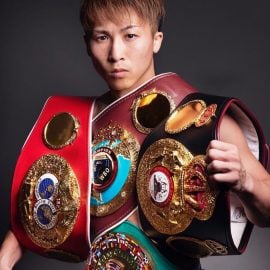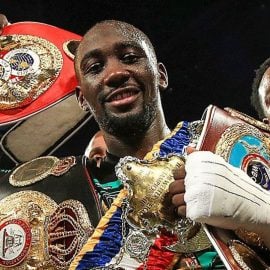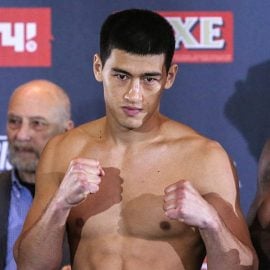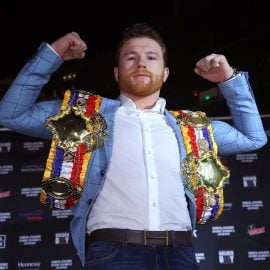Manny Pacquiao, Errol Spence Jr. and yet another WBA muddle
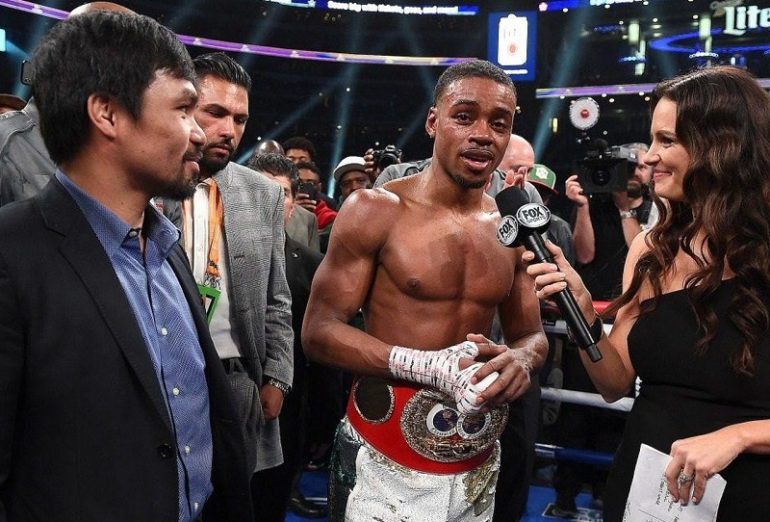
Last Friday, Manny Pacquiao announced via social media that he and unified WBC/IBF welterweight titleholder Errol Spence Jr. have agreed to fight August 21 at a site to be determined. At the end of one of the sport’s most tumultuous weeks in recent memory — Tyson Fury’s announcement that his superfight with Anthony Joshua had been made, a U.S. federal judge’s arbitration ruling that effectively scuttled that match in favor of Fury-Deontay Wilder III (now set for July 24), talk of a Joshua fight against either Oleksandr Usyk or Dillian Whyte in August, and the showdown between Josh Taylor and Jose Carlos Ramirez that crowned a new undisputed champion at 140 — Pacquiao’s out-of-the-blue announcement injected further excitement and anticipation.
But that excitement and anticipation soon turned to confusion when Boxrec.com initially listed Spence-Pacquiao as a unification of the WBC, IBF and WBA “super” championships (a listing that has since been removed). That’s because on January 30, the WBA — noting that Pacquiao had not fought since dethroning Keith Thurman in July 2019 and that he had not announced any upcoming matches — declared “The Pac Man” was now a “champion in recess” while also naming its secondary “world” titlist Yordenis Ugas the organization’s new “super” champion. For Ugas, it was a dizzyingly fast elevation –he won his share of the WBA title last September 6 by capturing a split decision against Abel Ramos — and by naming him “super” champion, the most widely-recognized version of the organization’s multi-tiered titular structure, he now had the power to induce Spence and WBO counterpart Terence Crawford into unification matches, for if they wanted to eventually become undisputed, boxing’s newest status symbol, they now would have to go through him…right?
If life were just, the answer would have been “yes.” But this is boxing, a sport where money not only talks, it bellows.
With Pacquiao back in the picture — and the massive attention he draws from mainstream media and casual sports fans — the WBA will be mightily tempted to reverse course and restore Pacquiao as its flagship champion thanks to the monstrous difference in sanctioning fee income the organization stands to receive with Pacquiao versus Spence as compared to Ugas versus anyone. While the Cuban is an excellent craftsman and a worthy adversary, he represents the classic “high risk/low reward” equation. Few people, Ugas included, boast the drawing power of the Filipino legend, one of a precious few fighters the “man on the street” could name if asked, with Roy Jones Jr., Mike Tyson and Floyd Mayweather being some of the others.

Man in the middle? Ugas (right) mixing it with Cesar Miguel Barrionuevo. Photo by Amanda Westcott/ Showtime
The magnetism of Tyson and Mayweather are illustrated by the fact that ABC is airing a two-part retrospective on “Iron Mike” in prime time while Mayweather stands to make at least eight figures — if not nine — by fighting June 6 on Showtime PPV against Logan Paul, a YouTube star who lost his pro debut against fellow social media star KSI. As for Jones, his exhibition with Tyson last November prompted outlets that normally would have ignored “The Sweet Science” to devote bundles of bandwidth to it, and, if the initial figure of 1 million buys can be believed, the enhanced attention paid off nicely. In this regard, Pacquiao is cut from their cloth, but if the WBA is to remain true to their rules, the WBA “super” title should not be included in the bounty for August’s showdown.
A generation ago, the WBC faced a similar situation regarding its heavyweight title as the WBA is now with the Pacquiao/Ugas quandary. The WBC handled the issue within its rules, and here’ how: After Vitali Klitschko stopped Danny Williams in eight rounds to retain his WBC championship in December 2004, he was obligated to meet mandatory challenger (and former champ) Hasim Rahman in April 2005. The fight was postponed when Klitschko pulled a thigh muscle and attempts to reschedule the match were thwarted after “Dr. Ironfist” injured his back. In November 2005 the match finally appeared to be a go on its fourth try but just days before the fight Klitschko tore a ligament in his right knee. Facing six more months of recovery, Klitschko announced his retirement.
On December 20, 2005, the WBC declared Klitschko a “champion emeritus,” which, like the WBA’s “champion in recess” status that Pacquiao currently enjoys, theoretically entitles an injured or retired champion first crack at his old belt should he choose to return. The WBC also authorized an August 2005 match between Rahman and Monte Barrett for the WBC “interim” title, which Rahman won by unanimous decision. After drawing with James Toney in March 2006, Rahman, elevated to “full” WBC champion after Klitschko announced his retirement in November 2005, lost it to Oleg Maskaev via 12th round TKO in August 2006. Maskaev, in turn, retained the belt by out-pointing Peter Okello in December 2006, then lost it to “interim” titlist Samuel Peter by sixth-round TKO in March 2008.
While all this was going on, Klitschko was rehabbing his injuries and had recovered to the point that he announced his return to boxing. He exercised his “champion emeritus” status to claim an instant title shot against Peter in October 2008. In stopping Peter in eight rounds, the 37-year-old Klitschko showed no signs of advanced age or 46 months worth of rust, and he subsequently produced a title reign lasting nearly four years and nine successful defenses, a run that led to his becoming a first-ballot Hall of Famer.
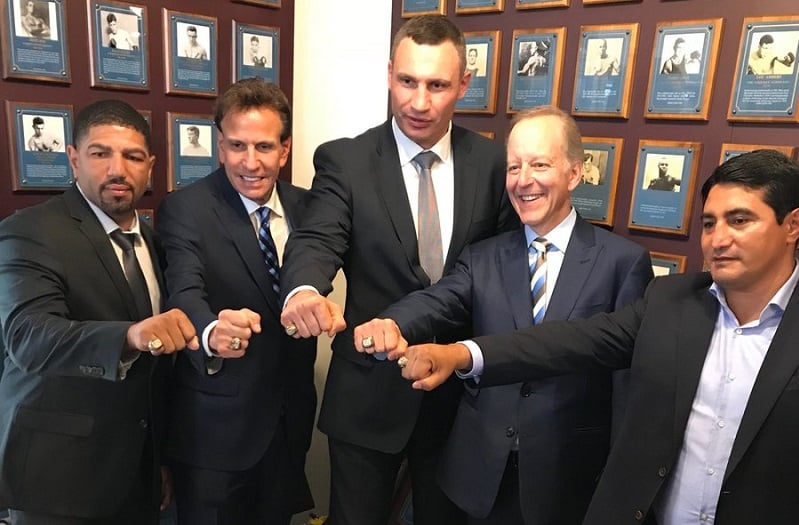
(From left to right) Ronald “Winky” Wright, Steve Albert, Vitali Klitschko, Jim Gray and Erik Morales. Photo courtesy of IBHOF
The WBA’s decision to strip Pacquiao of his “super” champion status and give it to Ugas should have triggered a series of events similar to those involving Klitschko, Rahman and, eventually, Peter: Pacquiao, the “champion in recess,” would have fought Ugas, the current “super” champion, and that winner would’ve met the winner of a Spence-Crawford fight for the undisputed championship. But since the Spence-Pacquiao fight has already been announced, here’s another scenario: Have “The Truth” and the “Pac Man” vie for Spence’s two belts and, since neither have any fights scheduled, Ugas should fight WBO counterpart Crawford with the winners to fight for all the marbles. While Ugas-Crawford in itself would not attract the kind of money Spence-Pacquiao would, the possibility of the winner fighting for the undisputed championship should add prestige — and cash — to the proceedings.
But because the lust for maximum money in the short term is so overwhelming, there is good reason to believe that the most cynical outcome will come to pass — elevate Pacquiao, relegate Ugas, and add the WBA “super” title to the Spence-Pacquiao pot.
If that happens, Ugas and his team would be incensed, and rightly so. But one fighter from the past, Graciano Rocchigiani, took his fury to another level — and he nearly killed the WBC in the process.
Here’s the story: In early 1998, Roy Jones Jr. decided to vacate the WBC light heavyweight title in order to move up to heavyweight and fight former champion James “Buster” Douglas on May 2 in Atlantic City. That prompted the WBC to order a fight between onetime IBF super middleweight titlist Rocchigiani and former two-division champion Michael Nunn that was clearly advertised as being for the vacant title, and, on March 21 in Berlin, “Rocky” won a split decision.
Meanwhile, Roy Jones Sr. told Roy Jones Jr. that he should remain at 175 because the father felt the son would be “risking his life” by fighting a man of Douglas’ size, skill and strength. Jones Jr. took his father’s advice and notified the WBC that he had changed his mind. The WBC responded by restoring the globally-known Jones as its “full” champion and demoting the lesser-known Rocchigiani to “interim” titlist, saying that the official rankings that had listed him as champion had been “a typographical error.” A bout between Jones and Rocchigiani was arranged for November 6, 1999 in Biloxi, Miss., but promoter Murad Muhammad canceled the match after the German southpaw failed to attend a press conference in New York. In response, the WBC stripped Rocchigiani of the “interim” belt.
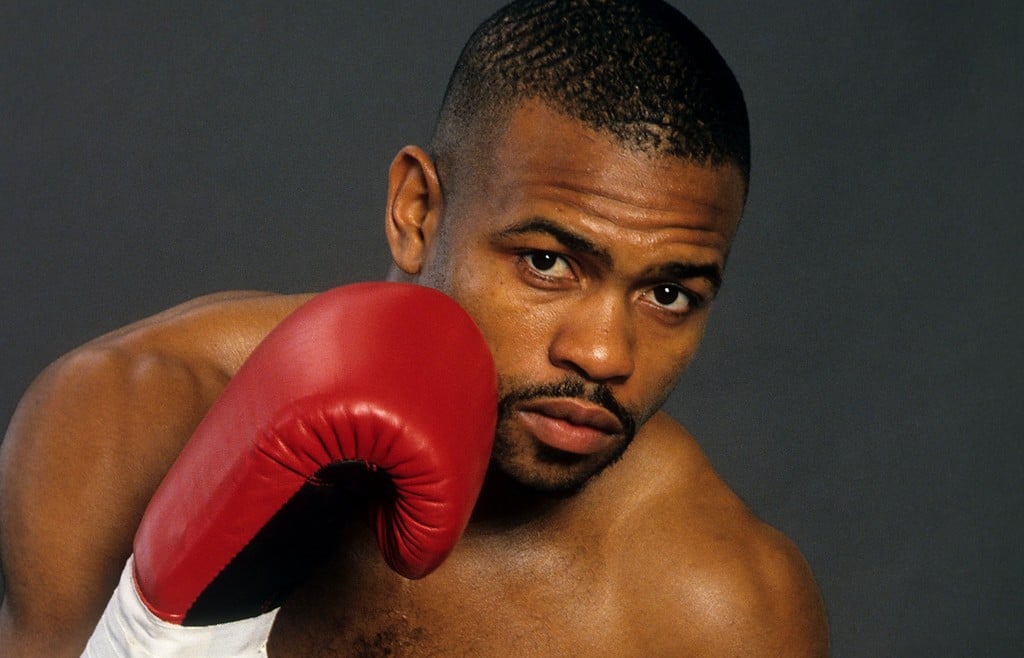
Can you remember when Roy Jones Jr. vs. Buster Douglas was almost a thing? Photo from The Ring archive
Rocchigiani sued the WBC and in April 2003 a New York court ruled in favor of the fighter, restoring his status as official WBC light heavyweight champion from March 28, 1998 to April 15, 2000, the date in which he lost his very next fight to Dariusz Michalczewski. But the real killer from the WBC’s perspective was the $31 million judgment that was handed down, a ruling that forced the organization to file for Chapter 11 bankruptcy protection. The next step was declaring Chapter 7 bankruptcy — an action that may well have led to the end of the WBC — but the mandated liquidation of assets to pay off the multi-million dollar bill was averted when the organization and Rocchigiani reached an agreement in August 2004, the terms of which were not revealed.
“We have gotten up off the canvas only seconds from disappearing,” then-WBC president Jose Sulaiman told the Associated Press.
If the WBA pulls the trigger and restores Pacquiao as its “super” champion, could we have a scenario in which we could substitute “Ugas” for “Rocchigiani” and the WBA for the WBC? Probably not, because in Rocchigiani’s case he had already engaged in a fight advertised for the WBC title, won it, then had it taken away while Ugas has yet to defend his newly-won “super” belt. If the WBA decides to demote Ugas, would it do so while also offering sweeteners, such as a fight with the winner of Spence-Pacquiao, or some short of financial reward? Years and circumstances have taught long-time observers that boxing’s capacity for back-room maneuvers is almost limitless.
As for this scribe, the fairest scenario for all concerned has already been laid out — Spence-Pacquiao for Spence’s belts and Ugas keeping his “super” belt and defending against Crawford if promotional roadblocks can be cleared. Whether that comes to pass is another question entirely. Until the WBA offers us clarity, all we as observers can do is wait.
*
Lee Groves is a boxing writer and historian based in Friendly, West Virginia. He is a full member of the BWAA, from which he has won 20 writing awards, including two first-place awards, since 2011. He has been an elector for the International Boxing Hall of Fame since 2001 and is also a writer, researcher and punch-counter for CompuBox, Inc. He is the author of “Tales from the Vault: A Celebration of 100 Boxing Closet Classics” (available on Amazon) and the co-author of “Muhammad Ali: By the Numbers” (also available on Amazon). To contact Groves about a personalized autographed copy, use the email [email protected] or send him a message via Facebook or Twitter (@leegrovesboxing).
SUBSCRIBE NOW (CLICK HERE - JUST $1.99 PER MONTH) TO READ THE LATEST ISSUE






